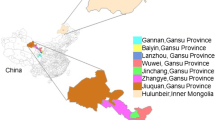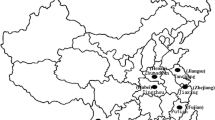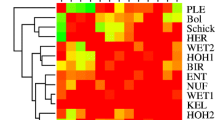Summary
Genome organization of the biotrophic barley powdery mildew fungus was studied using restriction fragment length polymorphism (RFLP). Genomic DNA clones containing either low-or multiple-copy sequences appeared to be the best RFLP markers, as they frequently revealed polymorphisms that could be readily detected. A total of 31 loci were identified using 11 genomic DNA clones as probes. Linkage analysis of the 31 RFLP loci and five virulence loci resulted in the construction of seven groups of linked loci. Two of these contained both RFLP markers and virulence genes. RFLP markers were found to be very efficient in characterizing mildew isolates, as only three markers were necessary to differentiate 28 isolates. The DNA of the barley powdery mildew fungus appeared to contain a considerable number of repetitive sequences dispersed throughout the genome.
Similar content being viewed by others
References
Apuya NR, Frazier BL, Keim D, Jillroth E, Lark KG (1988) Restriction fragment length polymorphism as genetic markers in soybean, Glycine max (L.) Merrild. Theor Appl Genet 75:889–901
Bernatsky R, Tanksley SD (1986) Toward a saturated linkage map in tomato based on isozymes and random cDNA sequences. Genetics 112:887–898
Birmboim HC, Doly I (1979) A rapid alkaline extraction procedure for screening recombinant plasmid DNA. Nucleic Acids Res 7:1513–1523
Burr B, Burr FA, Thompson KH, Albertson MC, Stuber CW (1988) Gene mapping with recombinant inbreds in maize. Genetics 118:519–526
Christ BJ, Person CO, Pope DD (1987) The genetic determination of the variation in pathogenicity. In: Wolfe MS, Caten CE (eds) Population of plant pathogens. Blackwell, Oxford London Edinburgh, pp 7–19
Edwards D, Kreiner S (1983) The analysis of constingency tables by graphical models. Biometrika 70:553–565
Feinberg A, Vogelstein B (1983) A technique for radiolabelling DNA restriction endonuclease fragments to high specific activity. Anal Biochem 132:6–13
Figdore S, Kennard W, Song K, Slocum M, Osborn T (1988) Assessment of the degree of restriction fragment length polymorphism in Brassica. Theor Appl Genet 75:833–840
Flor HH (1955) Host-parasite interactions in flax rust — Its genetics and other implications. Phytopathology 45:680–685
Giese H (1981) Powdery mildew resistance genes in the Ml-a and Ml-k region on barley chromosome 5. Hereditas 95:51–62
Giese H, Rasmussen SK, Jensen HP (1990) Extrachromosomal plasmid-like DNA in the obligate parasitic fungus Erysiphe graminis f. sp. hordei. Theor Appl Genet 79:56–64
Gruenbaum Y, Naveh-Many T, Cedar H, Razin A (1981) Sequence specificity of methylation in higher plant DNA. Nature 292:860–862
Havey MJ, Muehlbauer FJ (1989) Linkages between restriction fragment length, isozyme, and morphological markers in lentil. Theor Appl Genet 77:395–401
Helentjaris T, Weber D, Wright S (1988) Identification of the genomic locations of duplicate nucleotide sequences in maize by analysis of restriction fragment length polymorphisms. Genetics 118:353–363
Hermansen JE (1980) A spontaneous mutation in Erysiphe graminis f. sp. hordei for virulence to host gene Ml-g. Phytopathol Z 98:171–177
Hiura U, Heta H (1955) Studies on the disease resistance in barley. III. Further studies on the physiologic races of Erysiphe graminis hordei in Japan. Ber Ohara Inst Landwirts Biol 10:135–156
Hulbert SH, Ilott WT, Legg EJ, Lincoln SE, Lander ES, Michel-more RW (1988) Genetic analysis of the fungus, Bremia lactucae, using restriction fragment length polymorphisms. Genetics 120:947–958
Jensen HP, Jørgensen JH (1981) Powdery mildew resistance genes in northwest European winter barley varieties. Dan J Plant Soil Sci 85:303–319
Jørgensen JH (1988) Erysiphe graminis, powdery mildew of cereals and grasses. Adv Plant pathol 6:137–157
Kølster P, Munk L, Stølen O, Løhde J (1986) Near-isogenic barley lines with genes for resistance to Erysiphe graminis f. sp. hordei. Crop Sci 26:903–907
Krumlauf R, Marzluf GA (1979) Characterization of the sequence complexity and organization of the Neurospora crassa genome. Biochemistry 18:3705–3713
Maniatis T, Fritsch EF, Sambrook I (1982) Molecular cloning: a laboratory manual. Cold Spring Harbor Laboratory Press, Cold Spring Harbor/NY
McCouch SR, Kochert G, Yu ZH, Wang ZY, Kush GS, Coffman WR, Tanksley SD (1988) Molecular mapping of rice chromosomes. Theor Appl Genet 76:815–829
Moseman JG (1959) Host-pathogen interaction of the genes for resistance in Hordeum vulgare and for pathogenecity in Erysiphe graminis f. sp. hordei. Phytopathology 49:469–472
Moseman JG (1968) Reactions of barley to Erysiphe graminis f. sp. hordei from North America, England, Ireland, and Japan. Plant Dis 52:463–467
O'Dell M, Wolfe MS, Flavel RB, Simpson CG, Summers RW (1989) Molecular variation in population of Erysiphe graminis on barley, oats, and rye. Plant Pathol 38:340–351
Schwarzbach E (1979) Response to selection for virulence against the ml-o based mildew resistance in barley, not fitting the gene-for-gene hypothesis. Barley Genet Newslett 9:85–88
Sharp PJ, Kreis M, Shewry PR, Gale MD (1988) Location of α-amylase sequences in wheat and its relatives. Theor Appl Genet 75:286–290
Suiter KA, Wendel JF, Case JS (1983) Linkage-1: a PASCAL computer program for the detection and anaylsis of genetic linkage. J Hered 74:203–204
Tanksley SD, Miller J, Paterson A, Bernatsky R (1987) Molecular mapping of plant chromosomes. In: Gustafson JP, Apples RA (eds) Chromosome structure and function. Plenum Press, New York, pp 157–173
Tauts D, Renz M (1983) An optimized freeze-squeeze method for the recovery of DNA fragments from agarose gels. Anal Biochem 132:14–19
Timberlake WE (1978) Low repetitve DNA content in Aspergillus nidulans. Science 202:773–775
Torp J, Jensen HP, Jørgensen JH (1978) Powdery mildew resistance genes in 106 northwest European spring barley varieties. The Royal Veterinary and Agricultural University Yearbook, Copenhagen, pp 75–102
Wiberg A (1974) Sources of resistance to powdery mildew in barley. Hereditas 78:1–40
Author information
Authors and Affiliations
Additional information
Communicated by F. Salamini
Rights and permissions
About this article
Cite this article
Christiansen, S.K., Giese, H. Genetic analysis of the obligate parasitic barley powdery mildew fungus based on RFLP and virulence loci. Theoret. Appl. Genetics 79, 705–712 (1990). https://doi.org/10.1007/BF00226887
Received:
Accepted:
Issue Date:
DOI: https://doi.org/10.1007/BF00226887




